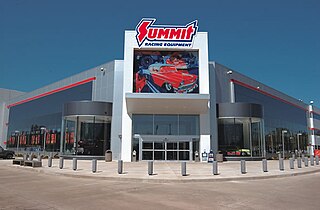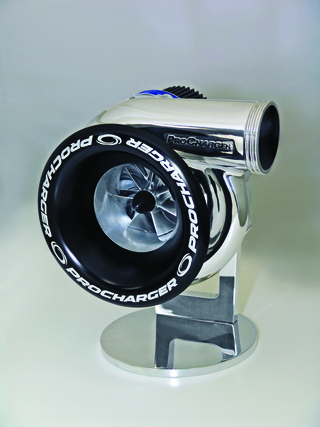
Drag racing is a type of motor racing in which automobiles or motorcycles compete, usually two at a time, to be first to cross a set finish line. The race follows a short, straight course from a standing start over a measured distance, most commonly 1⁄4 mi, with a shorter, 1,000 ft distance becoming increasingly popular, as it has become the standard for Top Fuel dragsters and Funny Cars, where some major bracket races and other sanctioning bodies have adopted it as the standard. The 1⁄8 mi is also popular in some circles. Electronic timing and speed sensing systems have been used to record race results since the 1960s.

The National Hot Rod Association (NHRA) is a governing body which sets rules in drag racing and hosts events all over the United States and Canada. With over 40,000 drivers in its rosters, the NHRA claims to be the largest motorsports sanctioning body in the world.

Funny Car is a type of drag racing vehicle and a specific racing class in organized drag racing. Funny cars are characterized by having tilt-up fiberglass or carbon fiber automotive bodies over a custom-fabricated chassis, giving them an appearance vaguely approximating manufacturers' showroom models. They also have the engine placed in front of the driver, as opposed to dragsters, which place it behind the driver.

Top Fuel is a type of drag racing whose dragsters are the quickest accelerating racing cars in the world and the fastest sanctioned category of drag racing, with the fastest competitors reaching speeds of 338 miles per hour (544.0 km/h) and finishing the 1,000 foot (304.8 m) runs in 3.62 seconds.
The International Hot Rod Association (IHRA) is the second-largest drag racing sanctioning body after the National Hot Rod Association (NHRA).

Car tuning is the modification of a car to optimise it for a different set of performance requirements from those it was originally designed to meet. Most commonly this is higher engine performance and dynamic handling characteristics but cars may also be altered to provide better fuel economy, or smoother response. The goal when tuning is the improvement of a vehicle's overall performance in response to the user's needs. Often, tuning is done at the expense of emissions performance, component reliability and occupant comfort.

Pro stock is a class of drag racing featuring "factory hot rods". The class is often described as "all motor", due to the cars not using any form of forced induction such as turbocharging or supercharging, or other enhancements, like nitrous oxide, along with regulations governing the modifications allowed to the engines and the types of bodies used.

Top Alcohol refers to two different classes in professional drag racing: Top Alcohol Dragster and the Top Alcohol Funny Car. Commonly known as "alky" cars, both are akin in design to the premier Top Fuel classes, but less powerful. In both classes, the cars are either supercharged ("blown") engines, burning alcohol (methanol) or can burn nitromethane and be normally aspirated, fuel injected engines. Top Alcohol Dragsters and Funny Cars resemble their nitromethane (Fuel) counterparts, with about half the power of their respective classes. Each car uses a three-speed transmission.
Nostalgia drag racing is a form of drag racing using cars from the 1950s, 1960s and lately the 1970s.

In an internal combustion engine, a supercharger compresses the intake gas, forcing more air into the engine in order to produce more power for a given displacement.
Top Doorslammer is a professional (Pro) class of Australian drag racing. It caters to full-bodied racing sedans which are replicas of Australian or US production vehicles. The class uses 514 cu. in. displacement (8.5-litre), mechanically supercharged V8 engines which are fueled by methanol. The minimum weight break for these vehicles is 2700 lbs (1225 kg). It is similar to the Pro Modified class as defined by the NHRA.
Pro FWD is a class in drag racing. The E.T. Bracket categories are no-electronics classes. Delay devices, throttle stops, air shifters, transbrakes, etc. or any device that transmits real-time, on-track data to the driver or any remote location are prohibited. All applicable NHRA rules apply based on elapsed time.

Don Nicholson was an American drag racer from Missouri. He raced in the 1960s and 1970s when there were few national events. The National Hot Rod Association (NHRA) estimates he won 90 percent of his match races. As of 2002, he held the record for the most number of categories in which he reached a final round : Funny Car, Pro Stock, Super Stock, Competition Eliminator, Stock, and Street. He was nicknamed "Dyno Don" after he was one of the first drivers to use a chassis dynamometer on his cars in the late 1950s, a skill that he learned while working as a line mechanic at a Chevrolet car dealer.

Virginia Motorsports Park (VMP) is a 1/4 mile dragstrip in Dinwiddie County, Virginia, just outside of Petersburg. It opened in 1994 and originally hosted the NHRA's Virginia NHRA Nationals. It has a seating capacity of 23,000 spectators. After a brief time with IHRA beginning in 2010, the track returned to NHRA in 2012.

Bruce Larson (1937) is an American retired drag racer from Camp Hill, Pennsylvania. He became nationally known for his match races. He quit funny Car racing in 1972 after a bad fire and raced in the Pro Stock class for 2 years. He then returned to the Funny Car class and match racing until 1987 where he fought his way to the NHRA Funny Car Championship in 1989. He led the points chase from start to finish collecting 6 National Event wins, 5 runner ups and the Car Craft Funny Car Driver of the Year award. That championship car is now one of only 2 drag race cars in the collection of the Smithsonian Institution, the other being Don Garlits' rear engine dragster. He was inducted into the International Drag Racing Hall of Fame in 2006. Larson is remembered for his red, white, and blue USA-1 Chevrolet Camaros.

Dale Armstrong was a Canadian drag racer and crew chief. After winning 12 National Hot Rod Association (NHRA) and 12 International Hot Rod Association (IHRA) events in the 1970s, including the Pro Comp title in 1975, he became Kenny Bernstein's crew chief. The combination produced four consecutive national championships in Funny Car and another in Top Fuel. Bernstein became the first driver to top the 300 miles per hour mark in an engine tuned by Armstrong. Armstrong has been inducted in numerous halls of fame. He died on November 28, 2014, at his home in Temecula, California, at the age of 73. He had sarcoidosis.

Summit Racing Equipment is an automotive parts retailer with four retail stores and distribution centers located in Tallmadge, Ohio; Sparks, Nevada; McDonough, Georgia; and Arlington, Texas. Summit Racing Equipment is also involved in motorsports and other events as a sponsor.

A gasser is a type of hot rod car originally used for drag racing. This style of custom car build originated in United States in the late 1950s and continued until the early 1970s. In the days before Pro Stock, the A/Gas cars were the fastest stock-appearing racers around.

ProCharger is the automotive supercharger division of Accessible Technologies, Inc. (ATI), a manufacturer of centrifugal compressor technology in multiple industries, located in the Kansas City metropolitan area. Inovair is the name of the company’s industrial products division.
Altered is a former National Hot Rod Association (NHRA) drag racing class and a current drag racing chassis configuration that forms the basis of many classes of NHRA Competition Eliminator.
















